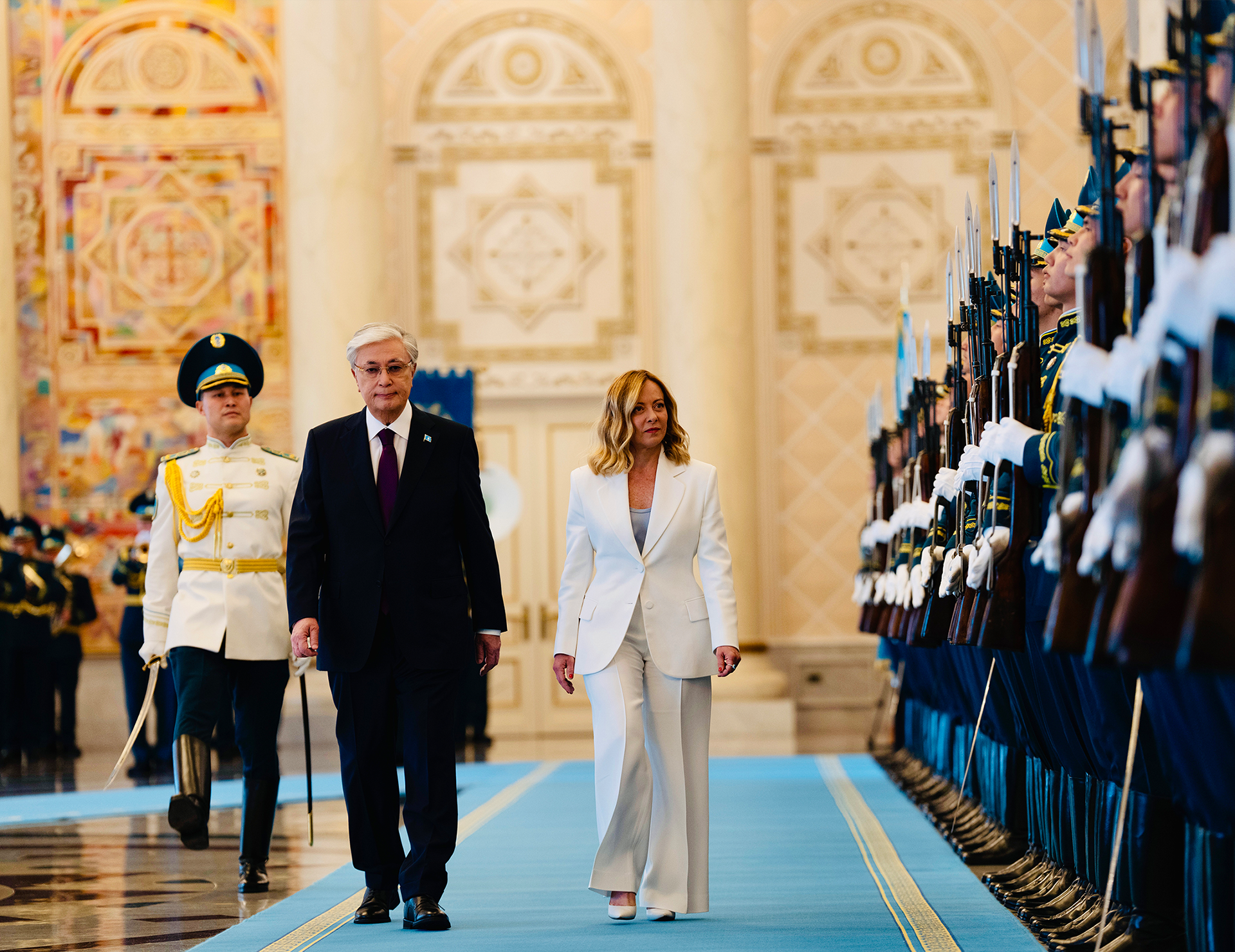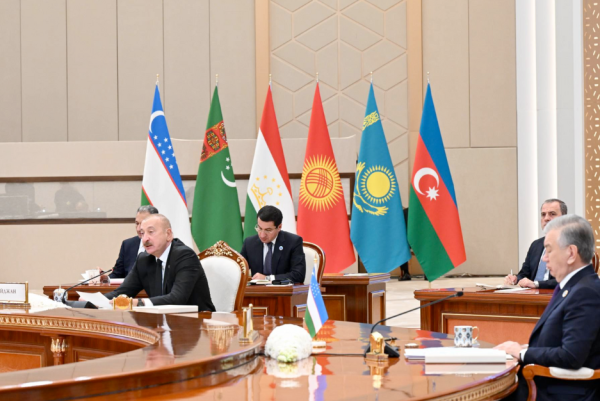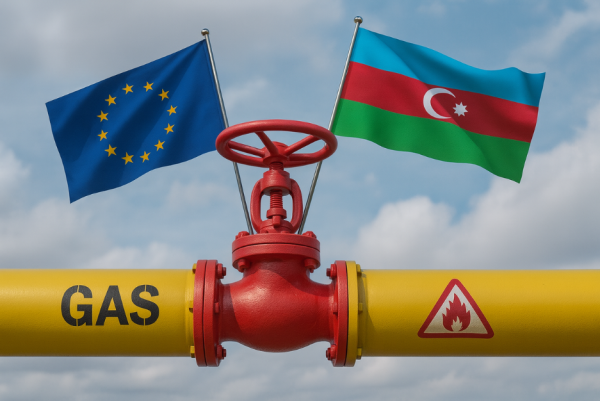Italy moves east: Meloni’s bid to rewire Central Asia partnerships

Italian Prime Minister Giorgia Meloni visited Uzbekistan and Kazakhstan on May 28-30, marking the highest-level effort to reinforce Italy’s strategic partnerships in Central Asia amid evolving great power competition over the region’s resources. Coming on the heels of the inaugural EU-Central Asia summit in April, the visit signalled Rome’s ambition to strengthen direct ties with the region while supporting broader European initiatives.
The economic motives have been the main driver behind this outreach. The foreign ministry’s new export plan, unveiled shortly before Meloni’s visit, identified the Turkey–South Caucasus–Central Asia corridor among the strategic priorities for diversifying Italy’s non-EU export destinations and securing access to new markets. Central Asia is a promising market for Italian machinery, energy technologies, and agro-industrial exports. Meanwhile, access to the region’s vast mineral reserves is expected to complement Rome’s efforts to establish sustainable supply chains that will fuel its economy. This aligns well with the Central Asian countries' desire for technology transfers from Europe to enhance industrial development and reduce their dependence on China and Russia.
In 2019, Italy was the first European country to launch the 5+1 cooperation framework with Central Asian states at the level of foreign ministers. It was also the only G7 country to sign on to China’s Belt and Road Initiative in 2019, only to withdraw in 2023 as Meloni’s foreign policy took on a distinctly Euro-Atlantic tone and China’s backing of Russia’s war in Ukraine contributed to the climate of mistrust. Much like the EU, France, and Germany, Italy has stepped up its diplomatic engagement with Central Asian states after February 2022. Presidents of Uzbekistan and Kazakhstan visited Italy in 2023 and 2024, respectively. Italian President Sergio Mattarella travelled to Uzbekistan in 2023 and Kazakhstan in 2025. The last meeting within the 5+1 framework was held in May 2024 in Rome, and the next gathering is planned for 2026. In this context, Meloni’s visit signifies the first high-level summit between a European country and the Central Asian Five in a regional capital. Previously, Central Asian leaders met then-German Chancellor Olaf Scholz in 2023, but in Berlin.
As expected, the joint summit declaration highlighted energy, critical raw materials, water, and trans-Caspian connectivity as focal points of the Italy-Central Asia strategic agenda. Kazakhstan’s oil has long dominated trade with Italy, and Rome is interested in keeping that momentum amid growing volatility in global energy markets. Italy’s energy giant Eni, already a shareholder in the Karachaganak and Kashagan oil fields, is expected to expand its footprint in Kazakhstan after the €4 billion deal signed during Meloni’s visit. Meanwhile, the company has set its sights on investing in Kazakhstan’s burgeoning renewable energy sector. Besides the 96 MW Badamsha wind farms in the Aktobe region, the newly approved 247 MW hybrid solar-wind-gas plant jointly developed with KazMunayGaz in Mangystau will give Astana its first sizeable, Italian-branded renewable energy infrastructure.
Yet, to lure Italian capital and technology, Kazakhstan and other Central Asian states need to undertake politico-economic reforms to ensure a predictable business climate. The joint declaration mentioned “the importance of establishing effective legal and regulatory frameworks to attract foreign investment in renewable energy projects”. Besides drawing greenfield FDI to local economies, these initiatives will help regional countries meet their climate commitments while ensuring energy security. Eni-led green projects in Western Kazakhstan may help alleviate chronic electricity shortages, free up fossil fuels for higher-value uses, and reduce dependence on imports from Russia. Kazakhstan and Uzbekistan also position themselves as potential green electricity suppliers to Europe through undersea cables in the Caspian Sea and the Black Sea.
In a longer-term perspective, the growing green capacity may provide a renewable backbone for green hydrogen projects, developed in partnership with European and Chinese companies. Currently, HyrasiaOne, a German-Swedish project to produce 2 million tons of hydrogen annually in Mangystau, is the boldest attempt to put Kazakhstan on the world’s hydrogen map. During Meloni’s visit, Italy’s Maire Tecnimont and Kazakhstan’s Samruk-Kazyna signed a memorandum of cooperation to design a modular complex in Mangystau that will feed wind-and-solar power into electrolysers that split water into hydrogen and eventually turn it into ammonia to be shipped by tankers. The Kuryk Port on the Caspian Sea is being equipped with new storage tanks, a dedicated jetty, and loading arms, allowing ammonia to be transported directly from the plants by pipeline or rail into seagoing vessels. In an ideal scenario, the tankers would cross the Caspian Sea to reach Baku, switch to rail for a short trip to Georgian ports in the Black Sea, and then sail to Mediterranean hubs such as Trieste, eventually tying into Italy’s planned SouthH2 corridor.
However, the high costs of cross-border hydrogen infrastructure and the still low industrial demand for clean hydrogen blur the prospects of Kazakhstan’s hydrogen exports in the short-to-mid term. Instead, Astana can leverage its deepening partnership with Italy and Germany on green hydrogen supply chains to localize its use in producing higher value industrial goods such as green fertilizer, green steel, or e-fuel. Green hydrogen could also help decarbonize Kazakhstan’s refineries, aluminium production, and chemical industry, preparing the country for the EU’s Carbon Border Adjustment Mechanism (CBAM) with capacity building and technical assistance from Italy.
The same goes for the Italy-Central Asia partnership on critical raw materials (CRMs). Meloni supported regional leaders’ desire for the creation of local value-added processing infrastructure, which may help diversify their economy and bring Italian technological know-how. Italy’s gains are twofold. Firstly, the proliferation of local processing plants will create demand for Italian technology, which the Italian machinery-making companies will use to their benefit. Secondly, Italy’s aerospace, green hydrogen, battery, and defense firms will gain access to titanium, beryllium, niobium, and rare earth elements, all abundant in Kazakhstan and Uzbekistan but scarce in Europe. It also aligns with the EU Critical Raw Materials Act’s quest for reducing dependence on a single supplier to less than 65 percent of its annual consumption. Currently, China is the leading source of CRMs supplies to the EU, and Brussels is going a long way to establish alternative supply chains as part of its de-risking efforts. The EU forged strategic partnerships on CRMs with Kazakhstan and Uzbekistan in 2023 and 2024, respectively. In Tashkent, Meloni and Mirziyoyev signed an agreement on CRMs cooperation. The question remains whether new agreements can unlock the region’s critical raw materials potential with minimal environmental harm, and/or risk saddling these countries with a new resource curse.
The push to develop hydrogen and critical raw materials in Central Asia also raises concerns over water security in a region already plagued by scarcity and fraught with cross-border tensions. Hydrogen facilities in Mangystau will desalinate Caspian seawater rather than tap scarce inland supplies, but it will still put pressure on the region’s fragile water ecosystem. Mangystau is hit by recurrent droughts and forecast 50 percent water shortfalls by 2040. The joint declaration came with a proposal to convene a roundtable on water and hydropower dialogue in the Central Asia + Italy format by 2026, with a focus on advancing technologies for sustainable energy production and efficiency. Addressing the Caspian Sea’s declining water levels is likely to feature in talks, given the strain it places on Kazakhstan and Azerbaijan’s strategic port infrastructure.
In Astana, Meloni pledged Italy’s support to bolster trans-Caspian connectivity under the EU’s Global Gateway program. Also known as the Middle Corridor, the trans-Caspian route gained renewed strategic significance after Russia’s invasion of Ukraine in February 2022 and recurring Red-Sea/Suez bottlenecks, offering Italy and the EU a viable alternative to the northern route through Russia for reaching Central Asia and China. While Italian rail and logistics firms stand to gain from new transport, infrastructure, and consulting projects, Central Asian economies could leverage this momentum to anchor themselves more deeply into Eurasian value and supply chains. At the Italy–Kazakhstan Supply Chain Forum on May 28, the two sides identified $8 billion in potential partnerships spanning energy, agriculture, logistics, and technology. Meanwhile, Italy’s strategic partnerships with Turkey and Azerbaijan - two key transit states to Central Asia - afford it a diplomatic edge the EU often lacks due to its sometimes complicated ties to Ankara and Baku. Rome’s pro-active stance on trans-Caspian connectivity can move things forward, especially as the EU Commission’s recent Black Sea paper calls for strengthened transport links with Turkey, Azerbaijan, and the Central Asian countries.
Taken together, Meloni’s visit showed a neat alignment of interests between Italy and its Central Asian partners. Yet converting lofty declarations into concrete results will require commitment and political will from all parties. Especially, Astana and Tashkent must deliver credible legal and environmental safeguards or risk seeing Italian firms move to less fraught jurisdictions. For Italy, the competition from better regionally-linked states - China, the Gulf states, and a slowly re-engaging United States - could crowd the field, driving up project costs and complicating access to rich deposits and strategic infrastructure. Italy - and the EU more broadly - lags in investment decisions due to bureaucratic and legal constraints, undermining its ability to compete with more flexible global players. If Rome can navigate these challenges in partnership with its Central Asian interlocutors, it stands a fair chance of turning a headline visit into a lasting regional footprint.







